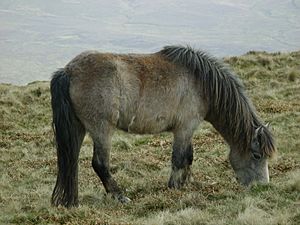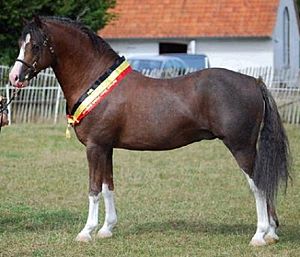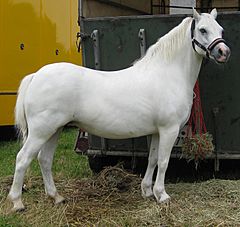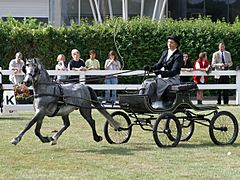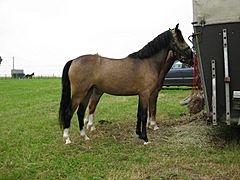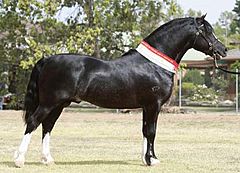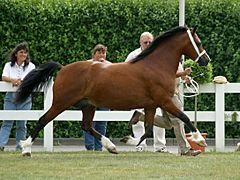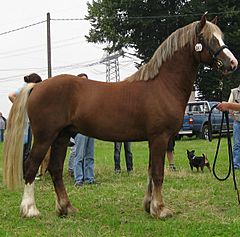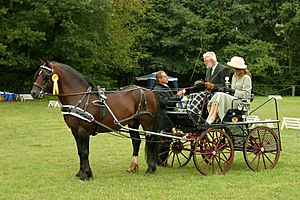Welsh Pony and Cob facts for kids
The Welsh Pony and Cob is a group of four related horse breeds. These amazing animals come from Wales. They include both small pony types and larger, stronger "cob" types.
There are four main types, called "sections." They are different mainly in how tall they are. Each section also has a slightly different look.
- The smallest is the Welsh Mountain Pony (Section A).
- The Welsh Pony of riding type (Section B) is a bit taller and very graceful. Kids often ride them in shows.
- The Welsh Pony of Cob Type (Section C) is smaller but very strong and sturdy. People use them for riding and for pulling carts in competitions.
- The tallest is the Welsh Cob (Section D). Adults can ride these powerful horses.
All Welsh ponies and cobs are known for being friendly and tough. They can move very freely and gracefully.
These ponies have lived in Wales for a very long time, even before 1600 BC. A Welsh-type cob was known as early as the Middle Ages. Over time, they got some blood from Arabian horses. They might also have some Thoroughbred and Hackney horse in them.
In 1901, the first official book for Welsh breeds was started in the United Kingdom. Another one began in the United States in 1907. People were less interested in them during the Great Depression. But their popularity grew again in the 1950s.
Welsh ponies and cobs have been used for many jobs throughout history. They were cavalry horses for soldiers. They worked as pit ponies in coal mines. They also helped out on farms.
Today, Welsh ponies and cobs are popular in many horse sports. These include showing, jumping, and driving. They are also great for pleasure riding and trail riding. The smaller types are perfect ponies for children. Welsh ponies also mix well with other breeds. They have helped create many other British and American horse and pony breeds.
Contents
History of Welsh Ponies
There is proof that ponies lived in Wales before 1600 BC. The first Welsh Mountain Pony likely came from these ancient Celtic ponies. Welsh ponies mostly grew up in Wales. Their ancestors lived in the British Isles before the Roman Empire arrived. Herds of ponies roamed freely in the mountains. They climbed hills, jumped over ditches, and ran across rough land.
They became a very tough breed because of the harsh weather. There was little shelter and not much food in their home country. At some point, some Arab blood was added to the Welsh breeds. But this did not change their unique look.
The Welsh Cob type existed as early as the Middle Ages. Old Welsh stories mention these animals. Back then, they were known for being fast and good at jumping. They could also carry heavy loads. Before large "coldblood" draught horses were used, Welsh Cobs did farm work. They also helped with cutting timber.
In 1485, the Welsh Militia rode local horses. These horses were likely ancestors of the Welsh Cob. They helped Henry Tudor become the King of England. In the 15th century, similar small horses were also used as rounceys. These were horses that led destriers, which were war horses.
The look of the breed we know today was probably set by the late 15th century. This was after Crusaders came back to England. They brought Arab stallions from the Middle East. In the 16th century, King Henry VIII wanted to make horse breeds better. He especially wanted to improve war horses. He ordered that all male horses under 15 hands and all female horses under 13 hands be destroyed.
Luckily, a new rule by Queen Elizabeth I in 1566 changed this. Many ponies in their natural homes, like the Welsh breeds, were saved.
On Welsh farms, ponies and cobs did all kinds of work. They would plough fields. They carried farmers to market. They even took families to church on Sundays. When coal mining became important, many Welsh ponies worked in the mines. They pulled carts both above and below ground.
In the 18th and 19th centuries, more Arab blood was added. Stallions were let loose in the Welsh hills. Other breeds were also added, like the Thoroughbred and Hackney. Before cars, the Welsh Cob was the fastest way to travel in Wales. Business people often chose ponies by having them trot 35 uphill miles. The best ponies could do this in under three hours without stopping.
In 1901, breeders in England and Wales started the Welsh Pony and Cob Society. The first official book of horses was published in 1902. They decided to divide the Welsh horses into sections. These sections were based on their type and height.
At first, Welsh Ponies were only Section A. But in 1931, more people wanted ponies for children to ride. So, Section B was added. The rules for the different sections changed a few times. The current rules for Cobs as Sections C and D were set in 1949. Until the mid-1900s, the British War Office thought Welsh Cobs were very important. They paid extra money for the best male horses. After World War II, only three male horses were registered in Section C. But their numbers have grown since then.
A small group of about 120 wild Welsh ponies still lives in the Carneddau mountains in Snowdonia, Wales.
Welsh ponies first came to the United States in the 1880s. Many were sent between 1884 and 1910. They easily got used to the different lands and weather in Canada and the United States. An American group, also called the Welsh Pony and Cob Society, started in 1906. By 1913, 574 ponies were registered. During the Great Depression, fewer people were interested. But their popularity came back in the 1950s. The number of ponies kept growing. In 1957, 2881 ponies were registered. By 2009, there were more than 34,000. All Welsh ponies and cobs in the United States come from ponies registered in the UK.
Important Ancestors
A male horse named Dyoll Starlight was very important. He is seen as the main ancestor of the modern breed. He had both Welsh and Arab blood. From his family line came another important male horse, Tan-y-Bwlch Berwyn. He was the father of many Section B ponies.
Other important male horses for Section C and D lines include:
- Trotting Comet, born in 1840, from a long line of fast-trotting horses.
- True Briton, born in 1930, whose father was a trotter and mother was an Arab.
- Cymro Llwyd, born in 1850, whose father was an Arab and mother was a trotter.
- Alonzo the Brave, born in 1866, who had Hackney ancestors.
How Welsh Ponies Influenced Other Breeds
The Welsh Pony mixes well with many other breeds. It helped create the Pony of the Americas and the British Riding Pony. Many are also mixed with Thoroughbreds and other horse breeds.
The Welsh Pony helped start several other horse and pony breeds. The Morgan horse is one example. It partly came from Welsh Cobs left behind by British soldiers. These were left after the American Revolutionary War. Welsh ponies are mixed with Arab horses to make riding horses. They are also mixed with Thoroughbreds to make jumpers and eventers. Welsh female horses were also used to breed polo ponies. These ponies were very quick and agile. The Welsh Pony was used to create the Welara. This is a mix of the Welsh and Arab horse. It has been registered as its own breed in America since 1981.
Characteristics of Welsh Ponies
All types of Welsh ponies and Cobs have small heads with big eyes. They have sloped shoulders, short backs, and strong hind legs. Their front legs are straight, and their lower legs are short. Their tails are set high. The breed ranges from 11 hands (for the smallest ponies) to over 16 hands (for the tallest Cobs).
They can be any solid color. They cannot be spotted like a tobiano or leopard-spotted horse. Black, grey, chestnut, and bay are the most common colors. There are also buckskins and palominos. Sometimes, they are smoky blacks or double creams. People in Britain often call the buckskin color "dun." But the true dun gene is very rare in Welsh breeds.
Their movement is strong, free, and fast. This is especially true at the trot. They have great power from their back legs. Their trot is often compared to the Standardbred horse. They are known to be trustworthy and have a good, friendly nature. They are also full of energy and have great endurance. They are known for being tough, healthy, and very smart.
Welsh Pony Sections
| Section Description | Images |
|---|---|
| The Welsh Mountain Pony (Section A) is the smallest Welsh breed. Both Section A and Section B ponies are more graceful than those in Section C and D. They have big eyes and small heads. Their faces often have a dished shape from the Arabian influence. Their tails are set high. Their legs are refined but still strong.
The Welsh Mountain Pony (Section A) cannot be taller than 12.2 hands in the US. In the United Kingdom, they cannot be taller than 12 hands. |
|
| The Welsh Pony of Riding Type (Section B) is the second type in the Welsh pony group. The Section B Welsh Pony is a larger pony, good for riding. It is tough like the Section A. But it also moves gracefully and is athletic.
Section B ponies are taller than Section A. They can be up to 13.2 hands in the UK and 14.2 hands in the US. They are known for their graceful movement and athletic skills. They still keep the strength of their ancestors, the Section A Welsh Mountain pony. There is no lower height limit for them. Section B ponies are usually a bit lighter in build. This is because of Thoroughbred and Hackney blood. Section B ponies look like Section A ponies. But they are more of a "riding type." They should still have strong bones, like their Mountain Pony ancestors. Besides the good traits of Section A ponies, Section B ponies move very freely. They should have a muscular neck that arches from their shoulders to their head. They should also have a deep, wide chest. Section B ponies are often used as children's ponies. They are also popular as pony hunter-jumpers. |
|
| The Welsh Pony of Cob Type (Section C) cannot be taller than 13.2 hands. They are known for being strong, tough, and gentle. Unlike the Welsh pony (Section B), the Pony of Cob Type is heavier and more compact. They have a moderate amount of hair on their legs.
The Welsh Pony of Cob Type first came from mixing the Welsh mountain pony (Section A) and the Welsh Cob (Section D). Today, some Section C ponies still come from this mix. In the past, the WPCS also allowed Section C ponies with Section B blood. But that is no longer allowed. There were also mixes with Iberian horses. This led to the Powys horse, which also helped create this type. Other breeds also influenced the Section C. These include the Norfolk Trotter, the Hackney, and Yorkshire Coach Horse. The Welsh Pony of Cob Type is shown in jumping events. They are also used in harness, especially in competitive driving. |
|
| The Welsh Cob (Section D) is the largest type in the Welsh Pony and Cob breed. They must be taller than 13.2 hands. There is no upper height limit for them. They are used as riding horses for both adults and children. They are also used for driving. They are known for being tough and gentle.
Welsh Cobs are the tallest and strongest of the Welsh sections. But their heads still look like ponies, with big eyes and neat ears. Their legs might be quite short, also like a pony's. Adult male horses have somewhat thick necks. Female horses usually have thinner necks. Like the Section C, they move powerfully and showily. Grey coloring is rarer in the Section D Cob than other Welsh types. But bold white markings are common. Today, the Section D is best known for use in harness driving. But they are also shown under saddle and in hand. Like the other Welsh breeds, Cobs are also shown over fences. They compete as hunters and jumpers. |
|
Uses of Welsh Ponies Today
The Welsh Pony has been used for many things. In the past, they carried mail and worked in coal mines. The British War Office used the Welsh Cob to pull heavy guns and equipment. They could go through places where vehicles could not. They also used them for mounted infantry, which were soldiers on horseback.
Today, they are used as riding and driving ponies for both children and adults. Welsh ponies are also used in dressage, endurance riding, and general riding. They are good for hunting, jumping, and farm work. They have shown their skill in driving at high-level competitions. They have also been used for dressage. They compete against each other in breed shows as hunters, eventers, and western pleasure horses.
The skills of the Welsh Pony were shown in 2008. The first champion Large Pony Hunter to be made into a model Breyer horse was a grey Welsh Pony gelding.
See also
 In Spanish: Poni galés para niños
In Spanish: Poni galés para niños



